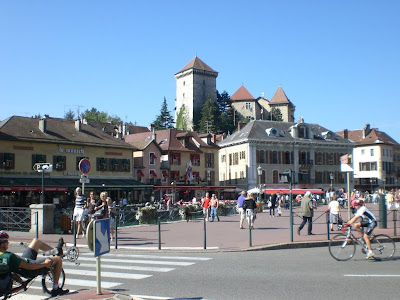So, Mr. Smart Guy (that’s me) came up with this brilliant plan—come to Annecy on a Sunday morning when everything is closed and I won’t have to deal with shoppers, tourists, truck deliveries and so on. Unlike in the USA, stores (including supermarkets) in Europe close on Sundays. The big downside to this plan? It means the pastry shops will also be closed.
So, upon arriving in Annecy imagine my horror in finding the old town area already packed with hordes of people! Why? Sunday is farmer’s market day and (of course!) it’s held in the old town with its narrow streets!
This first picture shows Palais de I‘Isle. Built in 1132 on an island in a canal, it’s been a home, a money mint, in medieval times & World War II a prison and now, a history museum. It’s reportedly one of the most photographed monuments in France. It’s a real beaut.
 So, you think I exaggerate about the crowds?
So, you think I exaggerate about the crowds? This is a shot away from the old town area.
This is a shot away from the old town area. Canals like this zig-zag through the city center.
Canals like this zig-zag through the city center. That's Chateau d'Annecy (Annecy Castle) atop the hill. It was built in stages between 1100 and 1500 and in 1953 the town acquired it. It's now a museum and after making my way up there I find most of it is under scaffolding as it's undergoing renovation. Jeez, the castle has been around for what? a thousand years and they wait for me to show up to begin doing repairs.
That's Chateau d'Annecy (Annecy Castle) atop the hill. It was built in stages between 1100 and 1500 and in 1953 the town acquired it. It's now a museum and after making my way up there I find most of it is under scaffolding as it's undergoing renovation. Jeez, the castle has been around for what? a thousand years and they wait for me to show up to begin doing repairs. This is a canal view as it heads out to the lake.
This is a canal view as it heads out to the lake. Lots of people enjoying the glorious weather.
Lots of people enjoying the glorious weather.
Look at the clear water.
 Can't even cycle on the walkway with all those pedestrians!
Can't even cycle on the walkway with all those pedestrians! This bridge, located about 20 miles from Annecy, was built in 1838 and until 1988 was the way across the deep gorge for motorized vehicles.
This bridge, located about 20 miles from Annecy, was built in 1838 and until 1988 was the way across the deep gorge for motorized vehicles.











































